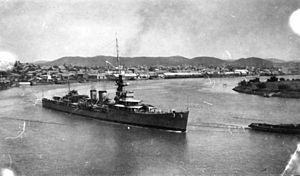HMS Dunedin
 Dunedin turning into Gardens Reach on the Brisbane River. South Brisbane wharves in background.
| |
| History | |
|---|---|
| Name | HMS Dunedin |
| Builder | Armstrong Whitworth Newcastle-on-Tyne: Hawthorn Leslie and Company, Hebburn |
| Laid down | 5 November 1917 |
| Launched | 19 November 1918 |
| Commissioned | 13 September 1919 |
| Identification | Pennant number: 96 (Aug 19);[1]93 (Nov 19); I.93 (1936); D.93 (1940)[2] |
| Fate | Sunk 24 November 1941 by U-124 |
| General characteristics | |
| Class and type | Danae-class light cruiser |
| Displacement |
|
| Length | 445 ft (136 m) |
| Beam | 46 ft 6 in (14.17 m) |
| Draught | 14 ft 6 in (4.42 m) |
| Propulsion |
|
| Speed | 29 knots (54 km/h) |
| Range | 2,300 nmi (4,300 km) |
| Complement | 462 |
| Armament |
|
| Armour |
|
HMS Dunedin was a Danae-class light cruiser of the Royal Navy, pennant number D93. She was launched from the yards of Armstrong Whitworth, Newcastle-on-Tyne on 19 November 1918 and commissioned on 13 September 1919. She has been the only ship of the Royal Navy to bear the name Dunedin (named after the capital of Scotland, generally Anglicised as Edinburgh).
Service history
[edit]In October 1920 she, with the other three British vessels, was sent to assure protection of the unloading of munitions intended for Poland, at Danzig.
In 1931 she provided assistance to the town of Napier, New Zealand, after the strong Hawkes Bay earthquake, in a task force with the sloop Veronica and the cruiser Diomede.
Second World War
[edit]Early in the Second World War, Dunedin was involved in the hunt for the German battleships Scharnhorst and Gneisenau after the sinking of the armed merchant cruiser Rawalpindi.
In early 1940 Dunedin was operating in the Caribbean Sea, and there she intercepted the German merchant ship Heidelberg west of the Windward Passage. Heidelberg's crew scuttled the ship before Dunedin could take her. A few days later, Dunedin, in company with the Canadian destroyer Assiniboine, intercepted and captured the German merchant ship Hannover near Jamaica. Hannover later became the first British escort carrier, Audacity. Between July and November, Dunedin, together with the cruiser Trinidad, maintained a blockade off Martinique, in part to bottle up three French warships, including the aircraft carrier Béarn.
On 15 June 1941, Dunedin captured the German tanker Lothringen and gathered some highly classified Enigma cipher machines that she carried. The Royal Navy reused Lothringen as the fleet oiler Empire Salvage. Dunedin went on to capture three Vichy French vessels, Ville de Rouen off Natal, the merchant ship Ville de Tamatave east of the Saint Paul's Rocks, and finally, D'Entrecasteaux.
Dunedin was part of the escort of Convoy WS 5A when it was attacked by the German heavy cruiser Admiral Hipper.on 25 December 1940. The attack was repulsed by other ships of the escort, without losses to the convoy.[3]
Dunedin was still steaming in the Central Atlantic Ocean, just east of the St. Paul's Rocks, north east of Recife, Brazil, when on 24 November 1941, at 1526 hours, two torpedoes from the German submarine U-124 sank her. Only four officers and 63 men survived out of Dunedin's crew of 486 officers and men.
Citations
[edit]- ^ Colledge, J J (1972). British Warships 1914–1919. Shepperton: Ian Allan. p. 50.
- ^ Dodson, Aidan (2024). "The Development of the British Royal Navy's Pennant Numbers Between 1919 and 1940". Warship International. 61 (2): 134–66.
- ^ Rohwer 2005, p. 53.
References
[edit]- Campbell, N.J.M. (1980). "Great Britain". In Chesneau, Roger (ed.). Conway's All the World's Fighting Ships 1922–1946. New York: Mayflower Books. pp. 2–85. ISBN 0-8317-0303-2.
- Colledge, J. J.; Warlow, Ben (2006) [1969]. Ships of the Royal Navy: The Complete Record of all Fighting Ships of the Royal Navy (Rev. ed.). London: Chatham Publishing. ISBN 978-1-86176-281-8.
- Friedman, Norman (2010). British Cruisers: Two World Wars and After. Barnsley, UK: Seaforth Publishing. ISBN 978-1-59114-078-8.
- Raven, Alan & Roberts, John (1980). British Cruisers of World War Two. Annapolis, Maryland: Naval Institute Press. ISBN 0-87021-922-7.
- Rohwer, Jürgen (2005). Chronology of the War at Sea 1939–1945: The Naval History of World War Two (Third Revised ed.). Annapolis, Maryland: Naval Institute Press. ISBN 1-59114-119-2.
- Whitley, M. J. (1995). Cruisers of World War Two: An International Encyclopedia. London: Cassell. ISBN 1-86019-874-0.
External links
[edit]- Danae-class cruisers of the Royal Navy
- Ships built on the River Tyne
- 1918 ships
- World War II naval ships of the United Kingdom
- Ships sunk by German submarines in World War II
- World War II shipwrecks in the Atlantic Ocean
- Maritime incidents in November 1941
- World War II cruisers of the United Kingdom
- Ships built by Armstrong Whitworth
